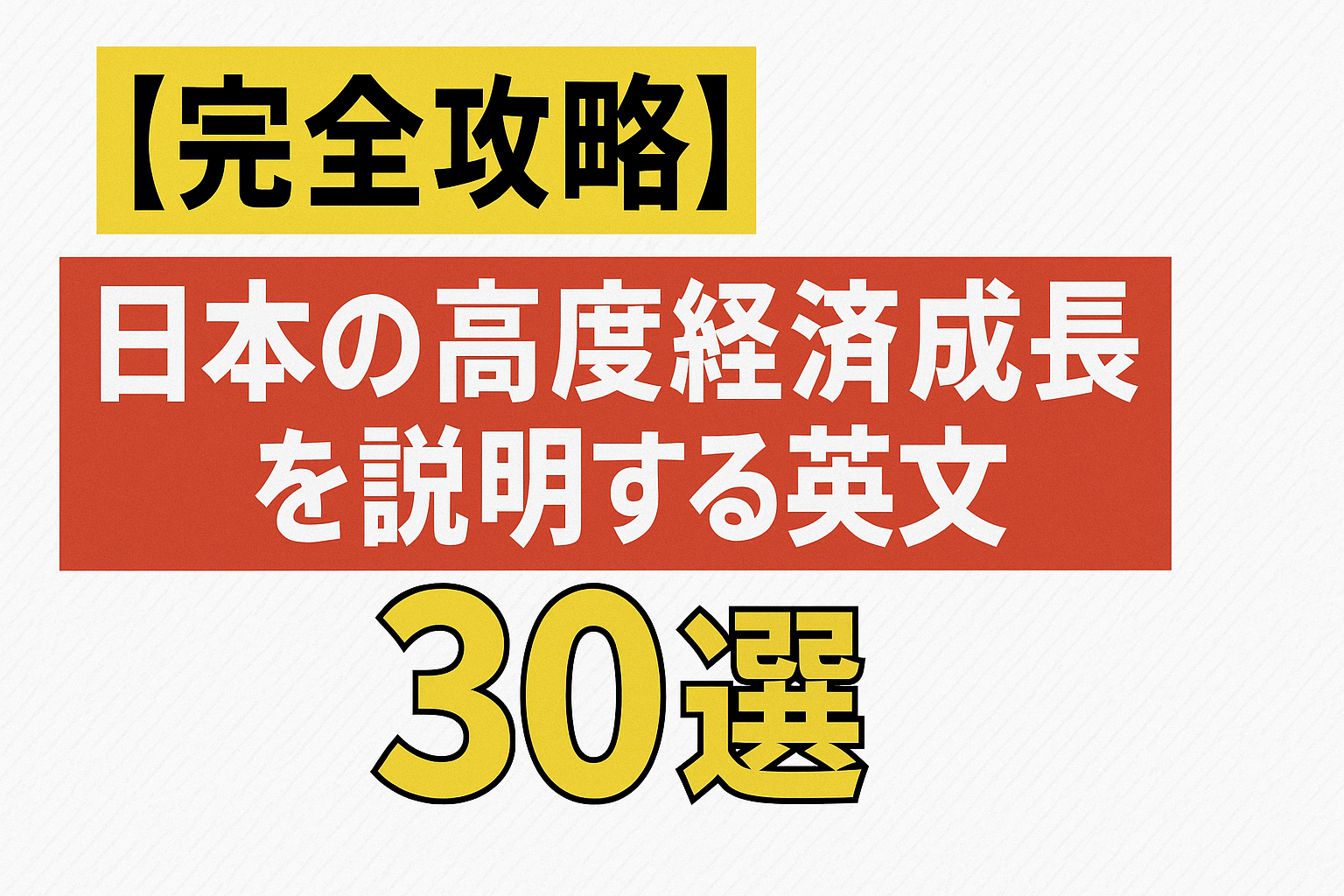今回は日本の高度経済成長を説明する英文30選を、時系列・要因別に整理してお届けします。
外国人の友人や同僚から
「日本の高度経済成長って何?」
「なぜ日本は戦後あんなに急速に発展したの?」「どうやって経済大国になったの?」
と聞かれた時、うまく説明できますか?
あらかじめ説明の型を押さえておくことで、ハードルが一気に下がるはずです。
サクッと確認してみましょう!
日本の高度経済成長と英語表現の基礎知識
基本的な高度経済成長用語
| 日本語 | 英語 |
|---|---|
| 高度経済成長 | High Economic Growth / Japanese Economic Miracle |
| 戦後復興 | Post-war recovery / Reconstruction |
| 経済大国 | Economic superpower |
| 技術革新 | Technological innovation |
| 輸出主導 | Export-driven growth |
| 終身雇用 | Lifetime employment |
| 年功序列 | Seniority-based system |
| 企業系列 | Corporate keiretsu |
日本の高度経済成長説明英文30選
基礎・背景(8文)
1955-1960:復興から成長へ
1. 高度経済成長の概要
- “Japan’s High Economic Growth period (1955-1973) transformed the country from war-torn ruins into the world’s second-largest economy.” (日本の高度経済成長期(1955-1973年)は、戦争で荒廃した廃墟から世界第2位の経済大国に国を変貌させました。)
- “The Japanese Economic Miracle achieved an average annual GDP growth rate of over 9% for nearly two decades.” (日本の経済奇跡は約20年間にわたって年平均9%以上のGDP成長率を達成しました。)
- “This unprecedented economic expansion lifted Japan from a developing nation to an advanced industrialized country.” (この前例のない経済拡大により、日本は発展途上国から先進工業国へと押し上げられました。)
2. 戦後復興の土台
- “The Korean War boom (1950-1953) provided crucial demand for Japanese industrial products, kickstarting economic recovery.” (朝鮮戦争特需(1950-1953年)は日本の工業製品に重要な需要を提供し、経済復興の起爆剤となりました。)
- “Post-war land reforms and zaibatsu dissolution created a more competitive economic environment.” (戦後の農地改革と財閥解体により、より競争的な経済環境が創出されました。)
- “The 1955 System established political stability under Liberal Democratic Party rule, supporting consistent economic policies.” (1955年体制は自由民主党政権下で政治的安定を確立し、一貫した経済政策を支援しました。)
- “American occupation policies and Marshall Plan-style aid helped rebuild Japan’s industrial infrastructure.” (アメリカの占領政策とマーシャル・プラン式援助が日本の産業インフラの再建を支援しました。)
- “The 1960 Income Doubling Plan set ambitious targets that mobilized national resources for economic development.” (1960年の所得倍増計画は経済発展のために国家資源を動員する野心的な目標を設定しました。)
産業・技術革新(8文)
1960-1965:重工業化の時代
3. 重工業の発展
- “Japan focused on heavy industries like steel, shipbuilding, and chemicals to build a modern industrial base.” (日本は近代的な工業基盤を構築するため、鉄鋼、造船、化学などの重工業に焦点を当てました。)
- “The petrochemical industry expanded rapidly, making Japan a major producer of synthetic materials.” (石油化学工業が急速に拡大し、日本は合成材料の主要生産国となりました。)
- “Japanese shipbuilding dominated global markets, producing the world’s largest and most advanced vessels.” (日本の造船業は世界市場を支配し、世界最大かつ最先進の船舶を生産しました。)
4. 技術導入と革新
- “Technology transfer from Western countries provided the foundation for Japan’s industrial modernization.” (西側諸国からの技術移転が日本の産業近代化の基盤を提供しました。)
- “Japanese companies excelled at improving and refining imported technologies rather than basic research.” (日本企業は基礎研究よりも、導入技術の改良と精製に優れていました。)
- “The automobile industry emerged as a global competitor through quality improvement and production efficiency.” (自動車産業は品質向上と生産効率により世界的競争相手として台頭しました。)
- “Electronics and precision machinery became Japan’s new competitive advantages in the 1960s.” (電子機器と精密機械は1960年代に日本の新たな競争優位となりました。)
- “Research and development investment increased dramatically, fostering indigenous technological capabilities.” (研究開発投資が劇的に増加し、独自の技術能力を育成しました。)
経済システム・政策(8文)
1965-1970:システム完成期
5. 政府の役割
- “The Ministry of International Trade and Industry (MITI) coordinated industrial policy and guided economic development.” (通商産業省(MITI)は産業政策を調整し、経済発展を指導しました。)
- “Administrative guidance allowed the government to influence business decisions without direct regulation.” (行政指導により、政府は直接規制なしに企業の決定に影響を与えることができました。)
- “Strategic protectionism shielded domestic industries while they developed international competitiveness.” (戦略的保護主義は国内産業が国際競争力を発展させる間、それらを保護しました。)
6. 企業システム
- “The lifetime employment system created loyal workforces and long-term corporate planning.” (終身雇用制度は忠実な労働力と長期的な企業計画を創出しました。)
- “Corporate keiretsu groups provided stable business networks and access to capital.” (企業系列グループは安定したビジネスネットワークと資本へのアクセスを提供しました。)
- “Quality control circles and continuous improvement (kaizen) became hallmarks of Japanese management.” (品質管理サークルと継続的改善(改善)が日本式経営の特徴となりました。)
- “High savings rates provided abundant capital for investment in productive capacity.” (高い貯蓄率が生産能力への投資に豊富な資本を提供しました。)
- “Labor-management cooperation facilitated workplace harmony and productivity improvements.” (労使協調が職場の調和と生産性向上を促進しました。)
国際貿易・社会変化(6文)
1970-1973:成熟と転換点
7. 輸出主導成長
- “Export-oriented industrialization made Japan a major player in global trade within two decades.” (輸出志向工業化により、日本は20年以内に世界貿易の主要プレーヤーとなりました。)
- “Japanese products gained international recognition for quality and reliability, challenging Western dominance.” (日本製品は品質と信頼性で国際的認知を獲得し、西側の優位性に挑戦しました。)
- “The 1964 Tokyo Olympics showcased Japan’s economic recovery and modern infrastructure to the world.” (1964年東京オリンピックは日本の経済復興と近代的インフラを世界に披露しました。)
8. 社会・生活の変化
- “Rising living standards created a prosperous middle class and consumer society.” (生活水準の向上により豊かな中産階級と消費社会が創出されました。)
- “Urbanization accelerated as people moved from rural areas to industrial cities for employment.” (雇用を求めて農村から工業都市に人々が移動し、都市化が加速しました。)
- “The oil crisis of 1973 marked the end of high-growth era, forcing Japan to adapt to new economic realities.” (1973年の石油危機は高成長時代の終わりを示し、日本は新たな経済現実への適応を迫られました。)
おわりに
いかがでしたか? 以上、日本の高度経済成長を説明する英文30選でした。
日本の高度経済成長は世界経済史上稀有な成功例です。ぜひ、適切な英語表現でその歴史的意義と現代への教訓を世界に発信してくださいね!




コメント